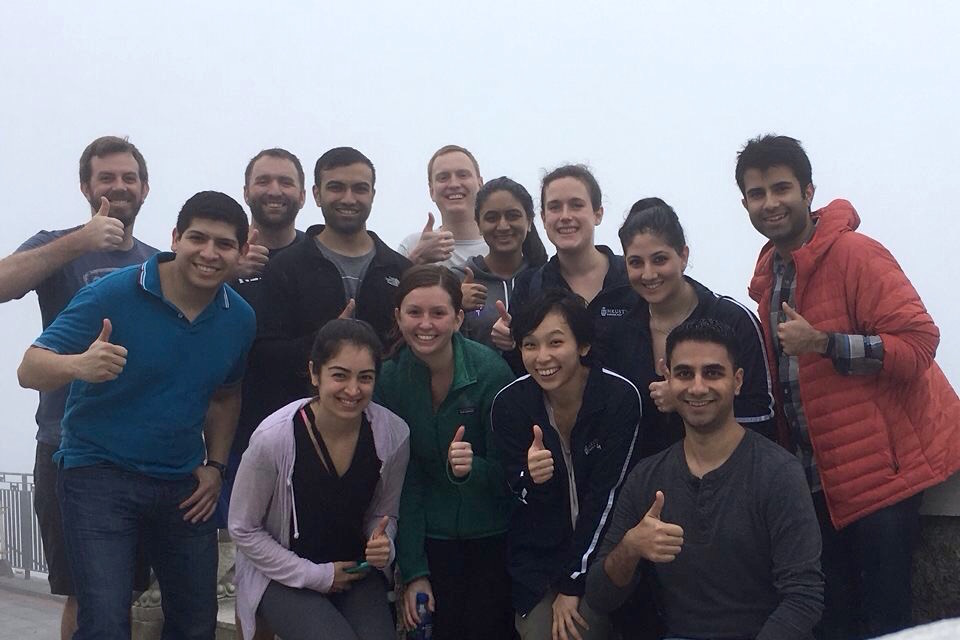Back in January, I traveled with 35 of my classmates to Hong Kong for one of the handful of “Doing Business in…” (DBi) courses offered each semester. With b-school lasting only a short two years, these one- or two-week courses are the most popular way for students to take advantage of Stern’s partnerships with international institutions and to expand their learning beyond the classroom and New York City.
Apart from a pre-departure meeting during the semester, the entire class takes place on location and consists of a balanced blend of classroom learning, corporate visits, and field trips to cultural sites. For my DBi, Stern partnered with the Hong Kong University of Science and Technology (HKUST), whose faculty, staff, and students welcomed us onto their campus with great hospitality. In the classroom, we learned about current social issues in China and how they have been influenced by geography, history, culture, and politics. We also examined the major opportunities and challenges that firms encounter, from the standpoints of both the foreign multinational companies, who tend to underestimate the costs of doing business in China, and the local Chinese companies, who are rising to compete against these corporate giants in the global market.
We were able to witness these successes and challenges in action at the companies we visited, which were chosen due to their relation to Hong Kong’s significant travel and tourism industry. My personal favorite was a trip to the MTR, the private Hong Kong-based corporation that runs the highly efficient mass transit railway system in Hong Kong and—as we learned during our visit—in other parts of the world as well. In addition to a quick tour of the control room at Kowloon Bay Station (where the MTR’s headquarters are located), we had the opportunity to hear directly from the Head of Operations, the Strategy and Planning Manager, and the Head of Town Planning about the MTR’s impressive operational achievements, profitable business models, and goals and aspirations moving forward and beyond Hong Kong. The executives also discussed the difficulties they are encountering as they grow their operations, such as meeting customer demands, fighting market competition, and navigating the complications and regulatory webs of foreign places and their governments.
Some of these successes and challenges were echoed at the other companies too. Uber invited us to their sleek new office, where we sat in their open kitchen and met with their regional head (who began at Uber as their first Hong Kong employee). Over the course of 90 minutes, he excitedly shared with us the firm’s successes in Hong Kong, highlighting the uplifting impact Uber has had on the lives of their drivers and customers. He also discussed the developments that have resulted from serving Hong Kong’s residents specifically—a service for the elderly called uberASSIST, as well as the city’s own UberEATS, whose incredible success in Hong Kong has inspired the firm to name each of its new meeting rooms after a food they deliver. Their office mascot also proudly bears the logo:

In addition, a visit to Hong Kong’s flag carrier airline Cathay Pacific exposed us to the company’s approach to addressing shifts in consumer behaviors and fighting off increased competition in a highly regulated industry. Moreover, on the tour of Cathay’s headquarters, led by the airline’s lovely flight managers, we had the opportunity to witness Cathay’s pre-flight crew procedures, sit in one of the pilot seats of a flight simulator, and lay back in the six pods that comprise the exclusive first class cabins of Cathay’s transoceanic planes (or in this case, a replica of one that is used for training). Later in the week, a visit to Ocean Park granted us insights into how the beloved amusement park managed to leverage its local understanding of its customers to differentiate itself from Disneyland and fend off the foreign goliath’s arrival. We were then set free into the park, where we observed various animals, raised our adrenaline on the array of rides, and took in aerial views of the park from the park’s signature cable cars, which also affords views of the South China Sea.

As if the corporate visits were not enlightening enough in themselves, so we could experience aspects of the local culture first-hand, Stern also arranged plenty of Cantonese-style meals and class trips to the Hong Kong Jockey Club and Po Lin Monastery (where the Big Buddha statue sits). Additionally, we had time on the weekend to explore on our own, giving us the chance to create even more memories with one another. For example, I’ll personally never forget that a group of us hiked up [the very steep] Victoria Peak one day to take in the breathtaking views we were promised only to encounter the whims of the weather and smog instead.

Indeed, in addition to the satisfaction of visiting Asia for the first time and getting to do something that I wrote about wanting to do in my admissions essay, I feel very fortunate to have been able to learn so much through these unique experiences and to be able to share them with such wonderful classmates. Whether we were touring a corporate headquarters or searching the streets for pork buns, I don’t think any of it would have been as exciting and memorable if my fellow Sternies were not by my side.
